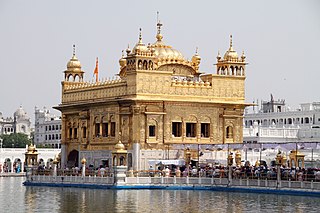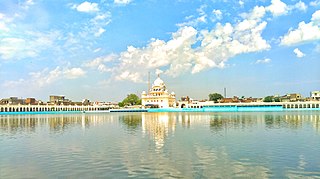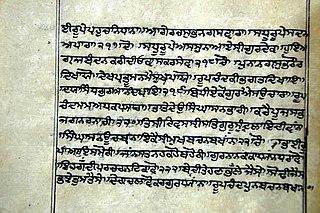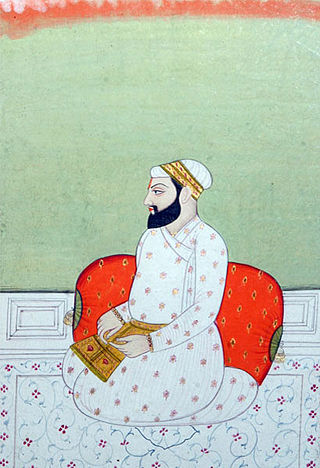
Sikhism, also known as Sikhi, is an Indian religion and philosophy in particular for the Sikh ethnoreligious group that originated in the Punjab region of India around the end of the 15th century CE. The Sikh scriptures are written in the Gurumukhi script particular to Sikhs. It is one of the most recently founded major religious groups and among the largest in the world, with about 25–30 million adherents.

Nankana Sahib is a city and capital of Nankana Sahib District in the Punjab province of Pakistan. It is named after the first Guru of the Sikhs, Guru Nanak, who was born in the city and first began preaching here. Nankana Sahib is among the most important religious sites for the Sikh religion. It is located about 91 km (57 mi) west of Lahore and about 75 km (47 mi) east of Faisalabad. According to the census of 2017 the city has a population of 110,135 inhabitants. Until 2005, it was a part of the Sheikhupura District.

Guru Angad was the second of the ten Sikh gurus of Sikhism. After meeting Guru Nanak, the founder of Sikhism, becoming a Sikh, and serving and working with Nanak for many years, Nanak gave Lehna the name Angad, and chose Angad as the second Sikh Guru.

The Guru Granth Sahib is the central holy religious scripture of Sikhism, regarded by Sikhs as the final, sovereign and eternal Guru following the lineage of the ten human gurus of the religion. The Adi Granth, its first rendition, was compiled by the fifth guru, Guru Arjan (1564–1606). Its compilation was completed on 29 August 1604 and first installed inside the Golden Temple in Amritsar on 1 September 1604. Baba Buddha was appointed the first Granthi of the Golden Temple. Shortly afterwards Guru Hargobind added Ramkali Ki Vaar. Later, Guru Gobind Singh, the tenth Sikh guru, added hymns of Guru Tegh Bahadur to the Adi Granth and affirmed the text as his successor. This second rendition became known as the Guru Granth Sahib and is also sometimes referred to as the Adi Granth.
The following outline is provides an overview of Sikhism, or Sikhi.

The Punjabis, are an Indo-Aryan ethnolinguistic group associated with the Punjab region of South Asia, comprising areas of present-day eastern Pakistan and northwestern India. They share a common history, culture and language; generally speaking Standard Punjabi or various Punjabi dialects on both sides.

Ik Onkar, also spelled Ek Onkar or Ik Oankaar ; literally, "one Om", hence interpreted as "There is only one God or one Creator") is a phrase in Sikhism that denotes the one supreme reality. It is a central tenet of Sikh religious philosophy.
Assū is the seventh month of the Punjabi calendar, as well as the Nanakshahi calendar, which governs the Sikh tradition.

The principal Sikh scripture is the Adi Granth, more commonly called the Guru Granth Sahib. The second most important scripture of the Sikhs is the Dasam Granth. Both of these consist of text which was written or authorised by the Sikh Gurus.
Guru Nanak founded the Sikh religion in the Punjab region of the northern part of the Indian subcontinent in the 15th century and opposed many traditional practices like fasting, Upanayana, idolatry, caste system, ascetism, azan, economic materialism, and gender discrimination.
Vaisakh is the second month in the Nanakshahi calendar and the Punjabi calendar.

Kartarpur is a town located, just 102 km from Lahore city in the Shakargarh Tehsil, Narowal District in Punjab, Pakistan. Located on the right bank of the Ravi River, it is said to have been founded by the first guru of Sikhism, Guru Nanak, where he established the first Sikh commune.

Sri Muktsar Sahib is a historical city and district headquarters in Punjab, India. The 2011 Census of India put the total population of Sri Muktsar Sahib municipality at 117,085, making it the 14th largest city of Punjab, in terms of population. The second Guru of the Sikhs, Guru Angad was born in the village Matte-di-Sarai (Sarainaga) in the same district. Earlier the city was called Khidrana/Khidrane di dhab, the city was named Muktsar after the Battle of Muktsar in 1705 and the district headquarters in 1995. The government officially changed the name of the city to Sri Muktsar Sahib in 2012, though the city is still primarily referred to by its unofficial name – Muktsar.

Bhat Vahis were scrolls or records maintained by Bhatts also known as Bhatra. The majority of Bhat Sikhs originate from Punjab and were amongst the first followers of Guru Nanak. Bhat tradition and Sikh text states their ancestors came from Punjab, where the Raja Shivnabh and his kingdom became the original 16th century followers of Guru Nanak, the founder of Sikhism. The Raja's grandson Prince Baba Changa earned the title ‘Bhat Rai’ – the ‘Raja of Poets, and then settled himself and his followers all over India as missionaries to spread the word of Guru Nanak, where many northern Indians became Bhat Sikhs. The majority were from the northern Brahmin caste ,(Bhat ) as the Prince Baba Changa shared the Brahmin heritage. The sangat also had many members from different areas of the Sikh caste spectrum, such as the Hindu Rajputs and Hindu Jats who joined due to Bhat Sikh missionary efforts. The Bhats also contributed 123 compositions in the Sri Guru Granth Sahib (pp.1389–1409), known as the "Bhata de Savaiyye". There hereditary occupations consisted of bards, poets, missionaries, astrologists, genealogists, salesmen.

Maghi is the regional name of the Hindu festival of Makar Sankranti celebrated in Punjab, Haryana Jammu division and Himachal Pradesh. In Himachal, the festival is also known as Maghi Saaji or Magha Ra Saza. In Bihar and Nepal it is also referred to as Maghi Parva or Maghi Sankranti. whereas it is known as Maghi Sangrand or Uttarain (Uttarayana) in Jammu and Sakrat in Haryana, Maghi is celebrated on first day of the month of Magh of Hindu Calendar. It follows on the heels of the mid-winter festival of Lohri which is marked by bonfires in North Indian fields and yards. The next morning Hindus see as an auspicious occasion for ritual bathing in ponds and rivers.

The Golden Temple (also known as the Harmandir Sahib, or the Darbār Sahib, is a gurdwara located in the city of Amritsar, Punjab, India. It is the pre-eminent spiritual site of Sikhism. It is one of the holiest sites in Sikhism, alongside the Gurdwara Darbar Sahib Kartarpur in Kartarpur, and Gurdwara Janam Asthan in Nankana Sahib.

Punjabi festivals are various festive celebrations observed by Punjabis in Pakistan, India and the diaspora Punjabi community found worldwide. The Punjabis are a diverse group of people from different religious background that affects the festivals they observe. According to a 2007 estimate, the total population of Punjabi Muslims is about 90 million, with 97% of Punjabis who live in Pakistan following Islam, in contrast to the remaining 30 million Punjabi Sikhs and Punjabi Hindus who predominantly live in India.

Guru Arjan was the fifth of the ten total Sikh Gurus. He compiled the first official edition of the Sikh scripture called the Adi Granth, which later expanded into the Guru Granth Sahib. He is regarded as the first of the two Gurus martyred in the Sikh faith.

The Guru Granth Sahib, is the central religious text of Sikhism, considered by Sikhs to be the final sovereign Guru of the religion. It contains 1430 Angs, containing 5,894 hymns of 36 saint mystics which includes Sikh gurus, Bhagats, Bhatts and Gursikhs. It is notable among foundational religious scriptures for including hymns from writers of other religions, namely Hindus and Muslims. It also contains teachings of the Sikh gurus themselves.

The following outline is provided as an overview of and topical guide to Punjab:




















